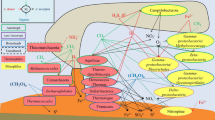Abstract
The distribution of aerobic chemoheterotrophic microorganisms within a 21 m3 section of deep subsurface rock was determined. Nineteen samples for microbiological analysis were aseptically taken by hand from the walls of a 400 m deep subsurface tunnel after an alpine miner created fresh rock faces 0.76, 1.52, 2.28, and 3.04 m into the tunnel wall. The direct counts were several orders of magnitude greater than viable counts in all samples. One of each morphologically distinct bacterial type from each sample was purified and analyzed for fatty acid methyl esters (FAME) using the Microbial Identification System (MIDI). Numbers of bacterial types, diversity, and equitability of recoverable microbial communities were the same or similar using either morphotype or FAME analyses as the basis for distinguishing between bacterial types. Twenty-nine genera (Euclidean distance of ⩽25) were found within the rock section, while 28 of the 210 bacterial types isolated were nonculturable under the growth regime required for cluster analysis. Most isolates clustered at the genus level with Arthrobacter, Gordona, and Acinetobacter. Two genera, containing 16 isolates, were unmatched to known organisms within the MIDI data base and clustered with other isolates at a Euclidean distance greater than 50. While some species (Euclidean distance ⩽10) were recovered from multiple sites within the rock section, most were found at 1–3 sites and usually without a definitive pattern of distribution.
Similar content being viewed by others
References
Amy PS, Haldeman DL, Ringelberg D, Hall DH, Russell CE (1992) Comparison of identification systems for the classification of bacteria isolated from water and endolithic habitats within the deep subsurface. Appl Environ Microbiol 58:3367–3373
Amy PS, Durham C, Hall D, Haldeman DL (1993) Starvation survival of deep subsurface isolates. Curr Microbiol 26:345–352
Atlas RM (1984) Use of microbial diversity measurements to assess environmental stress. In: Klug JF, Reddy CA (ed) Current perspectives in microbial ecology. American Society for Microbiology, Washington DC, pp 540–545
Atlas RM, Bartha R (1992) Microbial ecology fundamentals and applications. The Benjamin/ Cummings Publishing Company, Inc., Redwood City, California p 142
Balkwill DL (1989) Numbers, diversity, and morphological characteristics of aerobic, chemoheterotrophic bacteria in deep subsurface sediments from a site in South Carolina. Geomicrobiol J 7:33–51
Balkwill DL, Frederickson JK, Thomas JM (1989) Vertical and horizontal variations in the physiological diversity of the aerobic chemoheterotrophic bacterial microflora in deep southeast coastal plain subsurface sediments. Appl Environ Microbiol 55:1058–1065
Bone TL, Balkwill DL (1988) Morphological and cultural comparison of microorganisms in surface soil and subsurface sediments at a pristine study site in Oklahoma. Microbiol Ecol 16:49–64
Boylen CW, Ensign JC (1970) Intracellular substrates for endogenous metabolism during longterm starvation of rod and spherical cells of Arthrobacter crystallopoites. J Bacteriol 103:578–587
Box GE, Wilson KB (1951) Experimental attainment of optimal conditions. J Royal Stat Soc (ser B) 13:1–34
Brockman FJ, Kieft TL, Frederickson JK, Bjornstad BN, Li SW, Spangenburg W, Long PE (1992) Microbiology of vadose zone paleosols in south-central Washington State. Microbiol Ecol 23:279–301
Colwell FS (1989) Microbiological comparison of surface soil and unsaturated subsurface soil from a semiarid high desert. Appl Environ Microbiol 55:2420–2423
Colwell FS, Stormberg GJ, Phelps TJ, Birnbaum SA, McKinley J,Rawson SA, Veverka C, Goodwin S, Long PD, Russell BF, Garland T, Thompson D, Skinner P, Grover S (1992) Innovative techniques for collection of saturated and unsaturated subsurface basalts and sediments for microbiological characterization. J Microbiol Meth 15:279–292
Ensign JC (1970) Long-term starvation survival of rod and spherical cells of Arthrobacter crystallopoites. J Bacteriol 103:569–577
Fliermans CB (1989) Microbial life in the terrestrial subsurface of Southeastern coastal plain sediments. Hazard Waste Hazard Mater 6:155–171
Frederickson JK, Balkwill DL, Zachara JM, Li SW, Brockman FJ, Simmons MA (1991) Physiological diversity and distributions of heterotrophic bacteria in deep cretaceous sediments of the Atlantic coastal plain. Appl Environ Microbiol 57:402–411
Haldeman DL, Amy PS (1993) Bacterial heterogeneity in deep subsurface tunnels at Rainier Mesa, Nevada Test Site. Microbial Ecol 25:183–194
Haldeman DL, Amy PS (1993) Diversity within a colony morphotype: implications for ecological research. Appl Environ Microbiol 59:933–935
Keddie RM, Collins MD, Jones D (1989) Genus Arthrobacter Conn and Dimmick 1947, 300AL. In: Holt JG, Staley JT, Bryant MP, Norbert NP (eds) Bergey's manual of determinative bacteriology, 9th ed, vol 3. The Williams and Wilkins Co., Baltimore, p 1288
Kieft TL, Amy PS, Brockman FJ, Frederickson JK, Bjornstad BN, Rosacker LL (1993) Microbial abundance and activities in relation to water potential in the vadose zones of arid and semiarid sites. Microbial Ecol 26:59–78
Kolbel-Boelke J, Tienken B, Nehrkorn A (1988) Microbial communities in the saturated ground-water environment. I. methods of isolation and characterization of heterotrophic bacteria. Microbial Ecol 16:17–29
Kuznetzov SI, Dubinina GA, Laptev NA (1979) Biology of oligotrophic bacteria. Annu Rev Microbiol 33:377–387
MacDonell MT, Hood MA (1982) Isolation and characterization of ultramicrobacteria from a Gulf Coast estuary. Appl Environ Microbiol 43:566–571
Olsen RA, Bakken LR (1987) Viability of soil bacteria: optimization of plate-counting technique and comparison between total counts and plate counts within different size groups. Microbial Ecol 13:59–74
Phelps TJ, Rainne EG, White DC, Fliermans CB (1989) Microbial activities in deep subsurface environments. Geomicrobiol J 7:79–91
Poindexter JS (1981) Fast and famine existence. Adv Microbiol Ecol 5:63–89
Sinclair JL, Ghiorse WC (1989) Distribution of aerobic bacteria, protozoa, algae, and fungi in deep subsurface sediments. Geomicrobiol J 7:15–31
Trousselier M, Legendre P (1981) A functional evenness index for microbial ecology. Microb Ecol 7:283–296
Author information
Authors and Affiliations
Additional information
Offprint requests to: P. S. Amy.
Rights and permissions
About this article
Cite this article
Haldeman, D.L., Amy, P.S., Ringelberg, D. et al. Characterization of the microbiology within a 21 m3section of rock from the deep subsurface. Microb Ecol 26, 145–159 (1993). https://doi.org/10.1007/BF00177049
Received:
Revised:
Issue Date:
DOI: https://doi.org/10.1007/BF00177049




